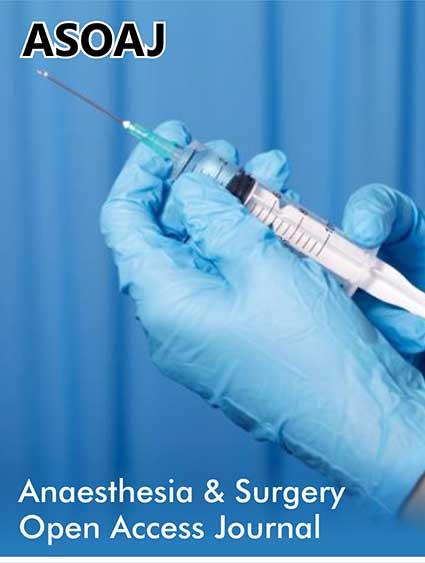 Case Report
Case Report
Scott Syndrome and Pregnancy: A Case Report
Aarjouni Youssef*, Chikhi Brahim, Hmadat Iyass, Jaafari Abdelhamid, Elwali Abderrahmane
Department of Anesthesia and Intensive Care, Military Hospital Mohammed V, Faculty of Medicine and Pharmacy of Rabat, Mohammed V University, Rabat, Morocco
Aarjouni Youssef, Department of Anesthesia and Intensive Care, Military Hospital Mohammed V, Faculty of Medicine and Pharmacy of Rabat, Mohammed V University, Rabat, Morocco
Received Date: November 18, 2024; Published Date: November 22, 2024
Abstract
Scott Syndrome (SS) is a rare congenital thrombopathy caused by a defect in phosphatidylserine (PS) exposure on activated platelets, leading to bleeding disorders. This autosomal recessive condition presents with mucocutaneous hemorrhages, often with normal routine hemostasis tests, complicating its diagnosis. Platelet flow cytometry is crucial for confirming the defect, identifying the absence of PS expression after platelet activation. We present the case of a 36-year-old woman with SS, diagnosed five years before her pregnancy, who carries a novel mutation in the ANO6 gene. Despite a history of early miscarriage and mild hemorrhagic episodes such as gingival bleeding, she had a successful pregnancy and delivery. The pregnancy was managed with a multidisciplinary approach, including platelet transfusions, antifibrinolytic therapy, and careful monitoring. She delivered vaginally at 41 weeks of gestation without hemorrhagic complications. This case highlights the importance of tailored prenatal care for women with rare thrombopathies, ensuring safe management of bleeding risks during pregnancy and childbirth.
Keywords: Scott Syndrome; Thrombopathy; Phosphatidylserine; ANO6 Gene Mutation; Pregnancy; Antifibrinolytics; Bleeding disorders
Introduction
Scott Syndrome (SS) is a rare congenital thrombopathy inherited in an autosomal recessive pattern. It is caused by a defect in the expression of phosphatidylserine (PS) on the surface of activated platelets [1]. Clinically, it manifests as a hemorrhagic syndrome with cutaneous and mucosal bleeding of varying intensity. Biologically, the first-line hemostasis tests may appear normal, which complicates diagnosis. SS is suspected when there is a consumption of prothrombin, and the diagnosis is confirmed through flow cytometry, which shows a defect in the expression of PS after platelet activation [2]. We present the case of a patient diagnosed with Scott syndrome and carrying a previously unreported mutation in the ANO6 gene, diagnosed 5 years prior to her pregnancy. The patient was homozygous for a mutation in exon 12 of the ANO6 gene. She was followed up in the Obstetrics and Gynecology department of the Mohamed V Military Instruction Hospital in Rabat, where she delivered vaginally under specific preventive measures, without any hemorrhagic incidents.
Patient and Observation
Patient Information: A 36-year-old woman, group A Rh+, G2P0, with a family history of consanguinity (first-degree), has been followed for Scott syndrome for 5 years. She had undergone a dental extraction 3 years earlier, which complicated with a palatal hematoma. She experienced an episode of metrorrhagia with no clinical consequences, and a history of early spontaneous abortion at 2 months gestation, complicated by prolonged metrorrhagia. A diagnostic work-up revealed a defective scramblase mechanism, which exposes procoagulant PS on the outer surface of activated platelets (Figure 1).

Timeline: Five years after the confirmation of Scott syndrome, the patient presented it for delivery. Her second pregnancy was estimated at 41 weeks gestation, confirmed by a precise last menstrual period and a 12-week ultrasound. Prenatal care included multiple routine check-ups and ultrasounds, all without any particularities. Notably, she did not experience any hemorrhagic syndrome during this pregnancy.
Diagnostic Approach: Given the high hemorrhagic risk, the patient was followed up by the hematology team, who conducted a first- and second-line hemostasis work-up. The tests revealed an extended Activated Partial Thromboplastin Time (aPTT) with a ratio of patient to control aPTT at 1.34, a slight deficiency in Factor XII (39%), normal platelet count and aggregation, and a reduced prothrombin consumption test (Figure 2). The diagnosis of Scott syndrome was confirmed after sequencing, which identified a mutation in ANO6 (Figure 3), and flow cytometry (Figure 4). Data from both clinical and paraclinical evaluations were shared between the obstetrics and hematology departments to plan the delivery. The patient presented at 41 weeks gestation in the latent phase of labor.



Clinical Results: Upon admission, the clinical and obstetric examination revealed a uterine height of 32 cm, with positive and regular fetal heart tones, and two contractions every 10 minutes. A speculum examination did not show any bleeding or fluid discharge.
Therapeutic Intervention: As epidural anesthesia was contraindicated, pain relief was managed with a combination of nefopam and paracetamol intravenously. During monitoring, cervical dilation progressed from 80% effaced to 4 cm within 45 minutes, and full dilation was achieved in 1 hour. She then delivered vaginally in an occiput-anterior position without episiotomy. The newborn was male, weighing 3620g, with an APGAR score of 10/10. The placenta was delivered artificially under sedation due to retained placental tissue. Throughout labor, antifibrinolytic therapy was routinely administered (1g tranexamic acid every 8 hours intravenously, then transitioned to oral therapy). Preventive platelet transfusions (2 platelet concentrates before delivery and 2 after delivery) were given, followed by 2 units of red blood cells.
Follow-up and Outcome of Therapeutic Interventions
Postpartum, both the mother and newborn had an uneventful recovery with no hemorrhagic complications. The patient was started on contraception with a microprogesterone pill on day 21 postpartum.
Informed Consent: The patient provided informed consent for the publication of her clinical case after being advised of the scientific value of sharing her rare pathology.
Discussion
Scott Syndrome is a rare inherited thrombopathy characterized by defective phosphatidylserine expression on the surface of activated platelets [3]. The condition predominantly affects females, with an estimated prevalence of 1 in 1,000,000 [4]. To date, only six cases of Scott Syndrome have been reported, with four of them undergoing sequencing of the ANO6 gene [5], which was the case for our patient. The pathophysiological mechanisms of SS are still not well understood [6]. At the cellular level, the syndrome involves the maintenance of lipid bilayer asymmetry on the membranes of blood cells, including platelets [7]. Activation of the enzyme scramblase leads to the exposure of PS, which promotes coagulation. ANO6, which encodes for phospholipid scramblase (TMEM16F), is located on the long arm of chromosome 12 (12q12) [8]. Genetic sequencing in our patient identified a c.1318C>T (p.Arg440) homozygous mutation in ANO6, which results in a nonsense codon for the first time. Our patient’s consanguinity may be a contributing factor in the homozygous mutation.
The syndrome is likely underdiagnosed due to its relatively mild clinical presentation and the normal first-line hemostasis tests [4]. Heterozygotes for ANO6 mutations are asymptomatic. Our patient experienced an episode of gingival bleeding associated with a hemorrhagic miscarriage. Other cases in the literature describe bleeding from the nose, gums, hematuria, petechiae, menorrhagia, and hemarthrosis [9]. In cases of suspected Scott syndrome, it is crucial to rule out other coagulation disorders, such as pseudo- Willebrand syndrome and Bernard-Soulier disease [10]. Flow cytometry can confirm the absence or deficiency of PS exposure on activated platelets.
Pregnancy in women with Scott syndrome is rare and poses a significant challenge in managing hemorrhagic risks during pregnancy, delivery, and the immediate postpartum period. There are no specific studies recommending against pregnancy for women with congenital thrombopathies, though caution is necessary. The five women in the literature who had children all experienced postpartum hemorrhage and required hysterectomy, with two maternal deaths. However, in our patient, delivery was uncomplicated with a term vaginal birth, despite a hemorrhagic syndrome after her first miscarriage.
Conclusion
Scott Syndrome is a rare disorder whose pathophysiological mechanisms are still being elucidated. Pregnancy and delivery in women with Scott syndrome require special preventive and curative measures due to the high hemorrhagic risk, especially in the postpartum period. Our patient was able to carry her pregnancy to terms and deliver vaginally without hemorrhagic complications. The management of pregnancy in women with SS remains delicate, requiring multidisciplinary care in centers capable of diagnosing this disease and managing both maternal and fetal complications.
Acknowledgement
None.
Conflicts of Interest
No conflict of interest.
References
- Aliotta A, Bertaggia Calderara D, Zermatten MG, Marchetti M, Alberio L (2021) Thrombocytopathies: not just aggregation Defects (the Clinical Relevance of Procoagulant Platelets). J Clin Med 10(5):
- Halliez M, Fouassier M, Robillard N, Ternisien C, Sigaud M, et al. (2015) Detection of phosphatidyl serine on activated platelets´ surface by flow cytometry in whole blood: a simpler test for the diagnosis of Scott Br J Haematol 171(2): 290-292.
- Weiss HJ (1994) Scott syndrome: a disorder of platelet coagulant activity. Semin Hematol 31(4): 312-319.
- Munnix I, Harmsma M, Giddings J, Collins P, Feijge M, et al. (2003) Store-mediated calcium entry in the regulation of phosphatidylserine exposure in blood cells from Scott patients. Thromb Haemost 89(4): 687-695.
- Toti F, Satta N, Fressinaud E, Meyer D, Freyssinet J (1996) Scott syndrome, characterized by impaired transmembrane migration of procoagulant phosphatidylserine and hemorrhagic complications, is an inherited disorder. Blood 87(4): 1409-1415.
- Stritt PNS, Remi F (2021) Inherited platelet diseases with normal platelet count: phenotypes, genotypes and diagnostic strategy. Haematologica 106(2): 337-350.
- Podda G, Femia EA, Pugliano M, Cattaneo M (2012) Congenital defects ofplatelet function. Platelets 23(7): 552-563.
- Suzuki J, Umeda M, Sims PJ, Nagata S (2010) Calcium- dependent phospholipid scrambling by TMEM16F. Nature 468(7325): 834-838.
- Naden AT (2006) Trombasteny Glanzmann. Orphanet J Rare Dis 6: 1-10.
- Nurden P, Nurden A (2008) Congenital disorders associated with platelet dysfunctions. Thromb Haemost 99(2): 253-263.
-
Aarjouni Youssef*, Chikhi Brahim, Hmadat Iyass, Jaafari Abdelhamid, Elwali Abderrahmane. Scott Syndrome and Pregnancy: A Case Report. Anaest & Sur Open Access J. 5(5): 2024. ASOAJ.MS.ID.000622.
-
Scott Syndrome, Thrombopathy, Phosphatidylserine, ANO6 Gene Mutation, Pregnancy, Antifibrinolytics, Bleeding disorders, Platelet activation, Metrorrhagia
-

This work is licensed under a Creative Commons Attribution-NonCommercial 4.0 International License.






